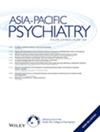预防自杀是可能的
IF 3.4
3区 医学
Q2 PSYCHIATRY
引用次数: 1
摘要
本文章由计算机程序翻译,如有差异,请以英文原文为准。
Prevention of suicide is possible
The 2019 report of the World Health Organization (WHO, 2019) showed – for the first time since its publication – a reduction of suicide rates in all but one region (America's) of the WHO. The number of people who died because of suicide in the most recent year reported was 10% lower than the number in the preceding report made more significant by the fact that the population of the world continued to increase. The incidence of suicide in the PR China (particularly among young women) in the 1980s was reported to be among the highest in the world: since then it has been reduced to a level similar to that seen in many European countries. The variation of suicide rates was explained by changes in the organization of health services, by control of pesticide availability and by a change of conditions related to urbanization (Phillips et al., 1999). A multicentre study of the World Health Organization (Fleischmann et al., 2008) showed the effectiveness of brief interventions to prevent suicide, in a variety of countries. Professor Hegerl's work (Hegerl et al., 2006) demonstrated that interventions by the health care sector (taken in collaboration with other social sectors) can lead to a reduction of suicide rates in urban settings. There are other studies and reports but the three examples mentioned above demonstrate that the incidence of suicide can be brought down by interventions by the health and social sectors and services; the WHO report however also shows that there are other factors which influence suicide rates, factors about which we still do not know enough. We could and should therefore hope that the future will see a universal application of measures of proven effectiveness in the prevention of suicide (e.g. the development of health services with a capacity to deal with suicide and suicide attempts) and a growth of the awareness that social change is a matter of life or death and must therefore be steered with care and humanitarian ideals in mind. At the same time, however a careful evaluation of effects of interventions and research on suicide and its prevention should continue and its results should help to guide action. The rates of suicide can be reduced and our action and behavior can make this happen.
求助全文
通过发布文献求助,成功后即可免费获取论文全文。
去求助
来源期刊

Asia‐Pacific Psychiatry
PSYCHIATRY-
CiteScore
7.80
自引率
0.00%
发文量
17
审稿时长
>12 weeks
期刊介绍:
Asia-Pacific Psychiatry is an international psychiatric journal focused on the Asia and Pacific Rim region, and is the official journal of the Pacific Rim College of Psychiatrics. Asia-Pacific Psychiatry enables psychiatric and other mental health professionals in the region to share their research, education programs and clinical experience with a larger international readership. The journal offers a venue for high quality research for and from the region in the face of minimal international publication availability for authors concerned with the region. This includes findings highlighting the diversity in psychiatric behaviour, treatment and outcome related to social, ethnic, cultural and economic differences of the region. The journal publishes peer-reviewed articles and reviews, as well as clinically and educationally focused papers on regional best practices. Images, videos, a young psychiatrist''s corner, meeting reports, a journal club and contextual commentaries differentiate this journal from existing main stream psychiatry journals that are focused on other regions, or nationally focused within countries of Asia and the Pacific Rim.
 求助内容:
求助内容: 应助结果提醒方式:
应助结果提醒方式:


